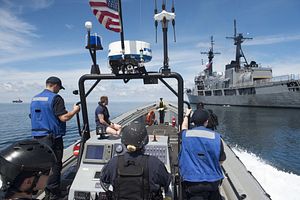On July 1, the U.S. Navy announced that the United States and the Philippines had completed a coordinated patrol in the Sulu Sea – the first publicly announced activity of its kind since Philippine President Rodrigo Duterte came to office last June. The interaction highlights the continuing cooperation between the two longtime treaty allies despite the challenges the relationship has faced thus far under Duterte.
The focus on the Sulu Sea, and U.S.-Philippine activity in the area, are both not really new. As I have noted previously, the one million square kilometer tri-border area in the Sulu-Sulawesi Seas between the southern Philippines, Indonesia, and Malaysia is notorious for its porous borders and decades of weak governance, which has unsurprisingly made it ridden with conflict, crime, and poverty, making it a hub for transnational organized crime and terrorist threats (See: “Confronting Threats in the Sulu-Sulawesi Seas: Opportunities and Challenges”).
Indeed, just last month, after much anticipation and several delays, Indonesia, Malaysia, and the Philippines finally jointly and publicly launched Trilateral Maritime Patrol (TMP) “Indomalphi” in Tarakan, Indonesia, the latest sign of progress for the indigenous minilateral initiative (See: “What’s Next For The New Sulu Sea Trilateral Patrols?”).
U.S-Philippine cooperation in the Sulu Sea is not really new either. Last year, in the midst of the Shangri-La Dialogue and in between the bilateral phases of the Cooperation Afloat Readiness and Training (CARAT) exercises that Washington does with the Malaysian and Philippine militaries, the U.S., Philippine, and Malaysian navies conducted a coordinated multilateral training activity in the Sulu Sea. As I noted then, the move reflected the U.S. view that the Sulu Sea is one promising avenue through which Washington can pursue multilateralization with ASEAN partners (See: “The Other Sea That Dominated Asia’s Security Summit in 2016”).
But with the emergence of Philippine President Rodrigo Duterte, U.S.-Philippine defense ties have been downgraded to a certain extent, with a few exercises and engagements being canceled including CARAT (See: “Where Are US-Philippine Defense Relations Under Duterte?”). On June 19, the two allies kicked off the first iteration of a new exercise under Duterte following CARAT’s cancelation that they termed a “Maritime Training Activity” called “Sama-Sama”.
As I pointed out, despite the change, the focus was on a similar list of common security concerns by both sides, including piracy, sea smuggling, maritime domain awareness and patrols, and humanitarian assistance and disaster relief (See “What’s in the First US-Philippines Downgraded Naval Exercise Under Duterte?”). The level of participation from U.S. assets was also neither insignificant nor remarkably distinct form the past couple of years.
Following Sama Sama, the two countries also conducted a coordinated patrol in the Sulu Sea. The activity was a clear demonstration of how both allies continue to find ways to cooperate operationally on priorities of common interest in spite of Duterte’s anti-American rhetoric and its impact on Philippine defense policy. It was also yet another testament to the adaptability of military exercises in the face of political change.
According to the U.S. Navy, crews from the Littoral Combat Ship USS Coronado and the Del Pilar Class Frigate BRP Ramon Alcaraz cooperated in to deterring and detecting threats to maritime security, with Philippine Navy sailors embarking on the USS Coronado to coordinate communications and movements between the two ships, and Philippine sailors also exchanging best practices with U.S. counterparts in visit, board, search, and seizure (VBSS) techniques and information sharing.
“The patrol strengthened maritime security cooperation between the U.S. and Philippine navies and enhanced both navies’ ability to respond to piracy and transnational criminal activity at sea,” the U.S. Navy said in a statement.
“It further demonstrates U.S. commitment to the security of the Philippines and enduring U.S. interest in promoting stability and prosperity in the Indo-Asia-Pacific region.”
To be sure, one should not overestimate the significance of a single exercise for a bilateral relationship or even defense ties more specifically. But as Donald Trump’s Asia policy develops and U.S.-Philippine interactions continue on for the rest of the year up to Trump’s potential summit meeting with Duterte, the Sulu Sea and U.S.-Philippine military relations are worth keeping an eye on.

































